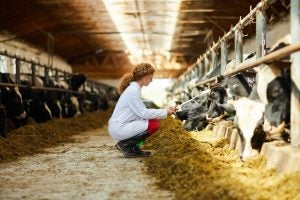While it’s uncommon for highly pathogenic avian influenza to affect mammals, the U.S. Animal and Plant Health Service has been tracking and studying limited detections, including those in dairy cattle in Kansas, Texas, and New Mexico.
After initially being dubbed a “mystery virus” going into Monday, HPAI was found in diagnostic samples from dairy operations later that day. Diagnostic samples of unpasteurized milk from affected cattle collected from two dairy farms in Kansas and one in Texas were confirmed to be positive for HPAI.
Another Texas dairy also confirmed the presence of HPAI through an oropharyngeal swab test. The Texas Department of Agriculture, The Texas Animal Health Commission, and the U.S. Department of Agriculture are closely monitoring the situation and its impact on Texas dairies.
“This outbreak has quickly grabbed the attention of the agriculture industry on a national level,” Texas Agriculture Commissioner Sid Miller said. “Understanding the details surrounding the transfer of avian virus to livestock is the top priority of animal health professionals and agriculture agencies. While troubling, this outbreak is not currently expected to threaten our nation’s commercial dairy supply.”
Wild birds may have introduced the HPAI virus detections in Texas. It is not confirmed if HPAI is the lone causative agent of reported bovine illness. National Veterinary Services Laboratories have not found alterations to the virus that would make it more transmissible to humans. The current risk to the public remains minimal. Further efforts are underway to continue epidemiological investigations to ensure a complete picture of the situation can be evaluated.

“Our producers in the Texas Panhandle have already endured enough,” said Miller. “The Texas Department of Agriculture will use every resource available to maintain the high standards of quality and safety that define Texas agriculture.”
Routine testing and well-established protocols for U.S. dairies will continue to ensure that only safe milk enters the food supply. Keeping with the federal Grade “A” Pasteurized Milk Ordinance, milk from sick cows must be collected separately and not allowed to enter the food supply chain. This means affected dairy cows are segregated, as is normal practice with any animal health concern, and their milk does not enter the food supply.
The USDA, TAHC, TDA, and other agencies continue to assess this situation to understand the role of HPAI in the affected cattle fully. At present, HPAI has not been detected in beef cattle. However, all producers are encouraged to implement enhanced biosecurity measures on their farms and ranches to help protect their herds.
“This new confirmed infection of dairy cattle is an unprecedented development,” Miller continued. “What we are doing now is working to get the facts straight. We anticipate more developments in the coming days. TDA and other state and national agencies are working around the clock to ensure the safety of our food supply.”
Cattle impacted by HPAI exhibit flu-like symptoms like fever and thick and discolored milk accompanied by a sharp reduction in milk production. The Food and Drug Administration, Center for Disease Control and Prevention, TAHC, Texas A&M Veterinary Medical Diagnostic Laboratory, and dairy veterinarians and other partners are working closely to evaluate symptoms among primarily older dairy cows in Texas, Kansas, and New Mexico. Symptoms may include decreased lactation, low appetite, and other clinical signs. It is vital that dairy facilities nationwide practice heightened biosecurity measures to mitigate further spread.
At present, HPAI has not been detected in beef cattle. However, producers are encouraged to implement enhanced biosecurity measures on their farms and ranches to help protect their herds.
If farmers believe dairy cattle within their herds are showing clinical signs, they are urged to contact their herd veterinarian immediately. Veterinarians at the dairy facility level can best assess these animals, decide on the appropriate supportive care for them, and determine the appropriate samples and diagnostics to be performed.


